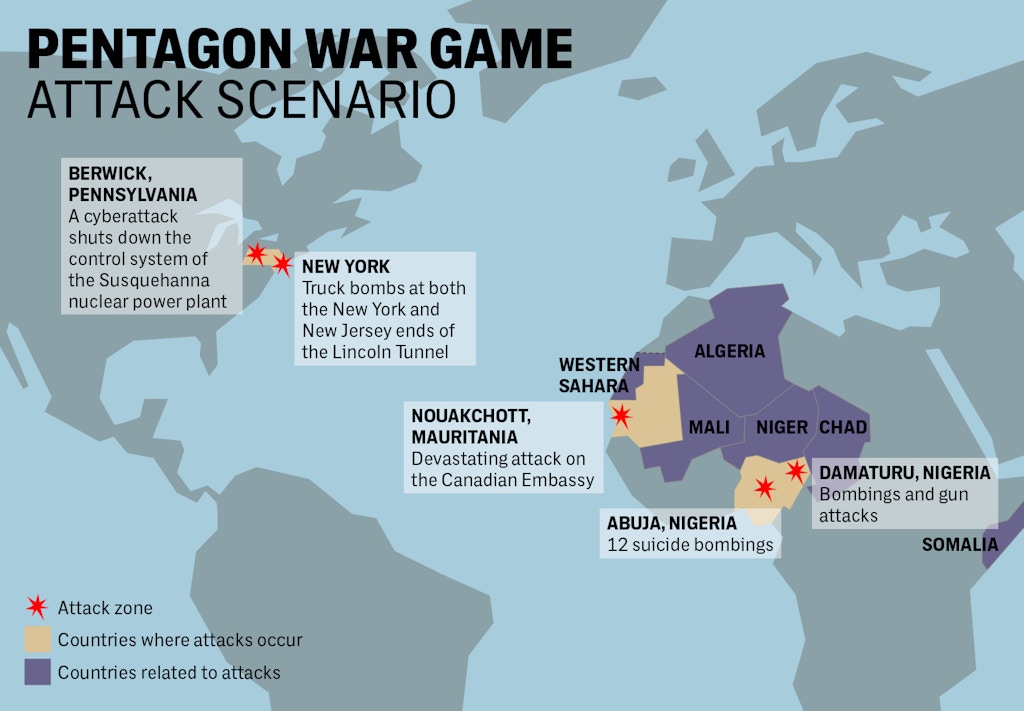
WHEN THE PENTAGON peers into its crystal ball, the images reflected back are bleak.
On May 23, 2023, in one imagining from the U.S. military, terrorists detonate massive truck-bombs at both the New York and New Jersey ends of the Lincoln Tunnel. The twin explosions occur in the southern-most of the three underground tubes at 7:10 a.m., the beginning of rush hour when the subterranean roadway is packed with commuters making their way to work.
The attack kills 435 people and injures another 618. Eventually, we’ll come to know that it could have been much worse. The plan was to drive the trucks to “high profile targets” elsewhere in Manhattan. Somehow, though, the bombs detonated early.
This spectacular attack, which would result in the highest casualties on U.S. soil since 9/11, isn’t the hackneyed work of a Hollywood screenwriter — it is actually one of the key plot points from a recent Pentagon war game played by some of the military’s most promising strategic thinkers. This attack, and the war it sparks, provide insights into the future as envisioned by some of the U.S. military’s most important imagineers and the training of those who will be running America’s wars in the years ahead.
The “5/23” terror attack was a small but pivotal part of a simulated exercise conducted last year by students and faculty from the U.S. military’s war colleges, which are the training grounds for prospective generals and admirals. Sprawling and intricate, the 33rd annual Joint Land, Air and Sea Strategic Special Program (JLASS-SP) brought together 148 students from the U.S. Air Force’s Air War College, the Army War College, the Marine Corps War College, the Naval War College, the Eisenhower School for National Security and Resource Strategy, the National War College, and the National Defense University’s Information Resources Management College. They collaborated for several weeks of remote war-gaming conducted via “cyberspace tools, telephones and video teleconferencing,” according to Pentagon documents obtained by The Intercept. It culminated in a five-day on-site exercise at the Air Force Wargaming Institute at Maxwell Air Force Base in Alabama.
The materials used in JLASS-SP — obtained via the Freedom of Information Act — detail the chaotic tenure of an imaginary 46th president, Karl Maxwell McGraw, and offer a unique window into the training of the Armed Forces’ future leaders. The documents consist of hundreds of pages of summary materials, faux intelligence estimates, fictional situation reports, and updates issued while the exercise was in progress — The Intercept is publishing one of these fictional situation updates here. They are highly detailed and, at a time when the press and lawmakers are increasingly asking questions about U.S. military involvement in Africa, offer a stark assessment of the potential perils of armed action there. While it is explicitly not a national intelligence estimate, the war game, which covers the future through early 2026, is “intended to reflect a plausible depiction of major trends and influences in the world regions,” according to the files.
MCGRAW, A FORMER independent Arizona senator who rode his populist “America on the Move” campaign to victory in the 2020 election, ushers in a wave of equally independent congressional candidates and the promise of “TRUE change” in Washington. His presidency is, instead, buffeted by a seemingly endless string of crises.
Just after entering office, in February 2021, a cyberattack shuts down the control system of the Susquehanna nuclear power plant in Berwick, Pennsylvania, “shaking the confidence of the American people in the government’s ability to protect critical infrastructure.” For the next two years, while dealing with the fallout from an Asian economic crisis, state-sponsored cybercrime, and the rise of new anti-globalism and right-wing extremist groups, the McGraw administration claims success in thwarting numerous overseas terror attacks, including a plot to bomb a number of U.S. embassies and consulates throughout Europe. But in West Africa, Al Qaeda in the Islamic Maghreb (AQIM) is expanding its presence and building on long-running failures of U.S. anti-terrorism efforts in the region, including U.S. support for French and African military operations that began in 2013 and now appear more or less permanent.
By 2021, according to the war game’s scenario, AQIM boasts an estimated 38,000 members spread throughout Algeria, Mali, Mauritania, and Niger, and a network of training camps in Mauritania, as well as outright bases in Western Sahara. At the same time, AQIM strengthens its ties with the terror groups al Shabaab in Somalia and Boko Haram in Central Africa’s Lake Chad Basin to create a “network of synchronization across the African continent and beyond,” including shared funding, training methods, and IED-making materials. As this pan-African Islamist terror cartel grows, so does AQIM’s global reach, eventually allowing it to carry out the devastating attack on the Lincoln Tunnel and another, that same day, on the Canadian Embassy in Nouakchott, Mauritania’s capital, killing 135 people including the Canadian Ambassador and his staff.
With near-complete congressional backing and the assent of the government of Mauritania, President McGraw joins forces with Canada to launch Operation Desert Strike. A major U.S. and Canadian ground force, backed by air and sea power, lands in Mauritania on June 15, 2023 with McGraw promising the American people a “well-planned, rapid, and efficient operation that would conclude in three years.” As with so many other American wars and interventions since 1945, however, U.S. military operations do not go as planned and instead seem to follow the well-worn path of America’s many other forever wars.

